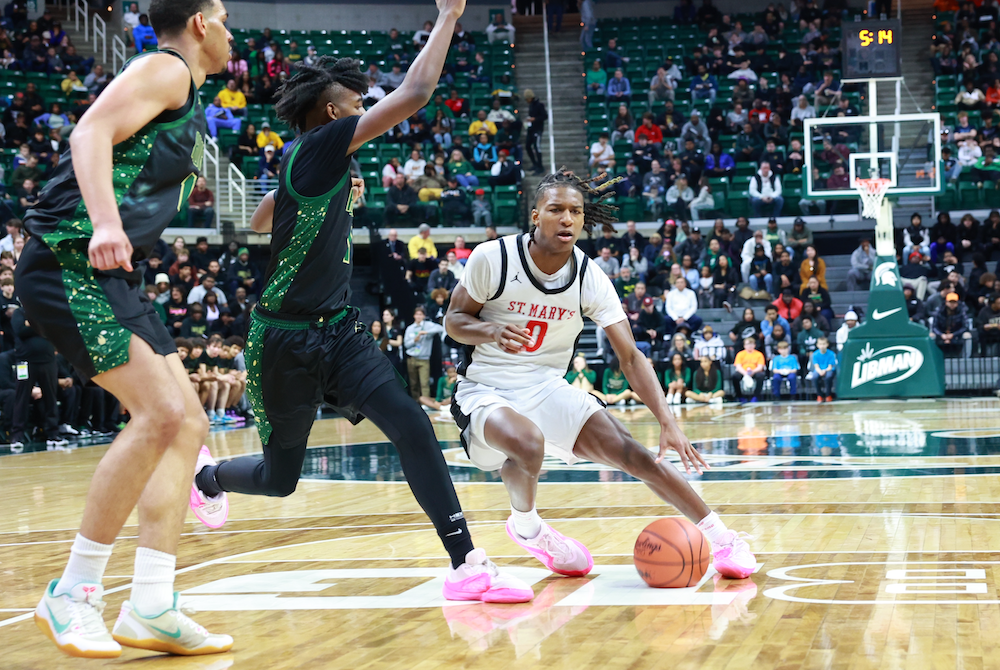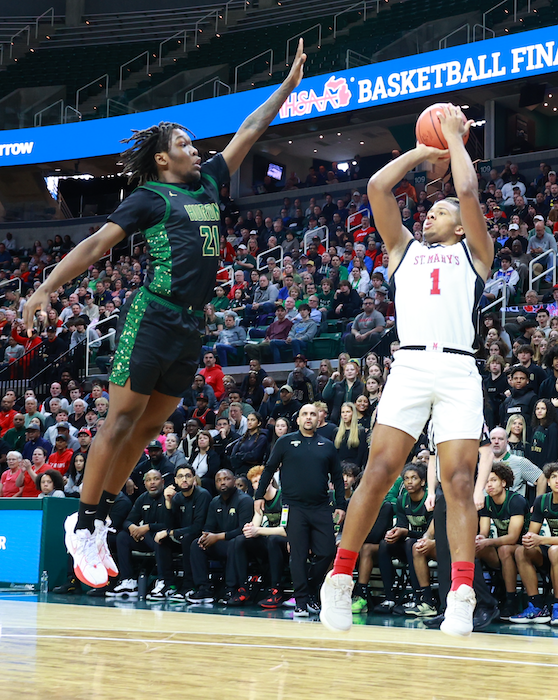
MHSA(Q&)A: Historian Ron Pesch
April 16, 2012
 When we receive a question on the history of MHSAA athletics that we can't answer on the spot, Muskegon's Ron Pesch is the first person we seek out for help.
When we receive a question on the history of MHSAA athletics that we can't answer on the spot, Muskegon's Ron Pesch is the first person we seek out for help.
Pesch took the reins as Michigan's chief high school sports historian during the mid 1990s after the retirement of legendary MHSAA record book originator Dick Kishpaugh and has contributed to various efforts and publications across the state.
One of his latest projects is the awarding of "retro" Mr. Basketball Awards. The first Hal Schram Mr. Basketball Award was given by the Basketball Coaches Association of Michigan in 1981 to Lansing Eastern's Sam Vincent. Three seasons ago, BCAM -- with research work by Pesch -- began awarding retro winners for the previous decades beginning with the 1920s. This winter, BCAM honored retro winners from 1922, 1932, 1942, 1952, 1962 and 1972.
Click to read more about those winners and the finalists recognized last month. Also, click for links to the previous retro winners. The retro Mr. Basketball project will last seven more seasons. Pesch explains more below.
How did you come up with rewarding a “Retro” Mr. Basketball?
The project came out of a conversation I had with (BCAM executive director) Tom Hursey at the basketball finals back in '99. Together, we hatched an approach honoring the state's past basketball greats. He let me run with it, while he worked on getting a subcommittee launched to make the selection.
How do you dig up all of this nomination info?
Between votes, I work on digging out the details. My initial target list always begins with all-state teams - if, of course they exist. All-tournament teams for the early years also serve as a starting point -- if they exist. Best I can tell, the Detroit Times, the Free Press and the News have all named all-state squads, at various points, back to about 1935. The Associated Press and UPI came to the game much later - somewhere around the early to mid 1960s. I then work on creating a crosstab on the players selected, noting the "teams" on which they were named (Class A 1st team, Dream Team, Class C 3rd team), and try to find quotes detailing their games. The result is really a reflection of the times and the history of newspaper reporting.
In early years, we can struggle to uncover a player’s first name, let alone his class in school. And statistical coverage of a player's abilities was very limited. It's simply the way things were back then. Everyone in town knew King Lewis, or Red Cherry, or Young Jacks. And the final box score only contained points, fouls, substitutions, as they were all you really needed to know about the game. But by visiting the state library in Lansing, and looking at a cross-section of newspapers, you can usually dig out what you need.
Do you collect from other sources as well?
Another source is high school yearbooks. Some resources have started to emerge online. I also tap into the MHSAA site and make contact with ADs around the state, asking for their assistance on digging out details - especially class in school. Like the current program, only "seniors" are considered for the award. Mid-year graduates can create a challenge, but the rule currently in place is a player is considered a nominee in the year in which he was last eligible for the state tournament. In other words, if you graduated in January or February of 1943, you would be considered for the 1942 ballot. It appears that a similar approach was used in selecting all-state teams.
|
Year |
Player |
High School |
Age |
Height |
Weight |
Year |
DFP |
DN |
DT |
AP |
UPI |
Tourney |
|
1971 A-1 G. |
Frank Tanana, Jr. (C) |
Detroit Catholic Central |
17 |
6-3 |
170 |
Sr. |
A1 |
A1 |
A1 |
A1 |
||
|
1971 A-1 C |
Tom McGill |
Flint Northern |
17 |
6-3 |
190 |
Sr. |
A1 |
DM |
A1 |
A1 |
||
|
1971 A-1 F. |
Lindsay Hairston |
Detroit Kettering |
17 |
6-9 |
203 |
Sr. |
A1 |
DM |
A1 |
A1 |
||
|
1971 A-1 F. |
Campy Russell |
Pontiac Central |
18 |
6-7 |
190 |
Sr. |
A1 |
DM |
A1 |
A1 |
That cross-tab table will help establish a list of nominees. A consensus first-team pick is an obvious candidate. When only a single all-state team is available, I'll do what I can to look up all-conference teams or all-area teams from around the state to see who else might be considered. While life after high school is not a considered when trying to pick a winner, a player who emerges as a star in college or in the pros may emerge as a candidate when you see his details in a local paper.
Bios are assembled from the newspaper reports, detailing as much as we can find on high school player's career. I'll tap into a variety of resources including old team histories when available. When needed, I'll toss out request to reporters, old and new, around the state. Local librarians and historians are another wonderful resource.
How does voting work?
Between sessions of the Boys Finals, the committee assembles to hash out a final ballot, and to make a selection. I don't vote, but I may guide the conversation and provide any additional details when needed, reminding members that we're focusing on their high school careers. The process is certainly imperfect. But the committee approach prevents the process from becoming a popularity contest. These guys have the benefit of watching many of the players play. And, like the current Mr. Basketball program, they sometimes surprise. But that's what makes it fun. And, of course, stirs the pot. It gets people talking about the history of basketball in this state.
Is there a theme to MHSAA basketball that has remained constant over the years?
For me the greatest thing about the basketball tournament is that it assembles a wide range of folks who want to see players they've heard about in action. And the process, for the most part, hasn't change since the 1920s. While the style of the game has changed, winning a title is much the same as it was back when our great-grandfathers played: You gotta get through the tournament. And only four trophies are awarded.
These guys were the "Magic" of their day. I'm hoping we never forget that.

St. Mary's Sharp in Breslin Return, Rides Strong Shooting to Semifinals Win
By
Steve Vedder
Special for MHSAA.com
March 15, 2024
EAST LANSING – Orchard Lake St. Mary’s is within a step of finishing off a year-long mission.
With Friday's impressive 82-42 Division 1 Semifinal win over Ann Arbor Huron, the Eaglets find themselves on the doorstep of wiping out last year's disappointment at the Breslin Center.
It's a disappointment that none of the returning players has forgotten, junior Trey McKenney said.
"We've been on a mission all year," McKenney said of playing in Saturday's 12:15 p.m. championship game. "We've taken it one day at a time all year. The last time we were on the biggest stage, we were hurt. Now we just want to get the job done."
Orchard Lake St. Mary’s (26-1) fell to Muskegon 65-42 in last year's Semifinal, a game in which the Eaglets shot only 26 percent from the field. It was a complete reversal Friday as they hit 52.7 percent (29 of 55) from the floor, including nine of 18 3-point attempts.
St. Mary’s, which upped its winning streak to 23 games, was in little jeopardy against Huron (22-5). The Eaglets scored 14 of the game's first 17 points, increased their lead to 39-17 at the half and 57-29 at the end of three quarters.
St. Mary’s junior Jayden Savoury said taking last year's playoff run two steps further has been on players' minds all season.
 "It's something that's been preached all season," he said. "We came up short last year, and all the accolades and awards don't mean anything because what you remember is a state championship."
"It's something that's been preached all season," he said. "We came up short last year, and all the accolades and awards don't mean anything because what you remember is a state championship."
McKenney led the team Friday with 20 points, 11 rebounds and six assists. Senior guard Daniel Smythe had 18 points and Savoury 14 points and eight rebounds.
Orchard Lake St. Mary’s coach Todd Covert said the quick start was key. Whereas the team made just six field goals in the first half against Muskegon a year ago, the Eaglets shot 50 percent from the floor in the first half against Huron, with seven 3-pointers.
"We tried to get out as fast as we could," Covert said. "We executed well and got the ball into (McKenney and Smythe’s) hands early. We had to be physical to get through their screens on defense. I thought we had a solid effort defensively; we tried to get in the gaps and eliminate space.”
After making the Semifinals a year ago, Eaglets players say they've been aware of having a target on their backs. The team hasn't lost since a 60-55 decision against Detroit U-D Jesuit in the fourth game of the season.
The fact they have typically battled opponents' best showings has actually worked for the team, McKenney said.
"There is a target because of last year's run," he said. "But we don't care. You don't win without having the best players in the state. We embrace pressure."
"We've been No. 1 all year, and people bring their best against us," Savoury said. "We think we have the best team, now we just have to prove it."
Huron coach Mohammad Kasham, whose team had won its MHSAA Tournament games by an average of three points per, said there is little doubt the Eaglets are a power. The game plan included playing a zone defense to offset St. Mary’s perimeter shooters.
"We ran into a buzzsaw," he said. "We picked the worst day of the year to have our worst shooting night. We missed a lot of shots we've made all season. We could never get on a run. We were outplayed and outcoached.
"Give them a lot of credit; they made the shots. We tried to be the best version of ourselves, and we didn't."
Macari Moore had 11 points for Huron.
PHOTOS (Top) Sharod Barnes (0) makes a move into the lane during Orchard Lake St. Mary’s Semifinal win Friday at Breslin Center. (Middle) St. Mary’s Trey McKenney (1) gets up a shot as Huron’s Macari Moore defends. (Photos by Hockey Weekly Action Photos.)

